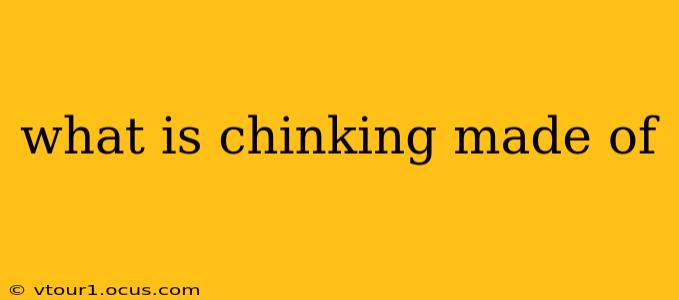Chinking, the process of sealing gaps in log cabins and other timber-framed structures, is crucial for maintaining energy efficiency, weather protection, and the overall structural integrity of the building. But what exactly is chinking made of? The answer isn't as simple as one material; the best chinking material depends on several factors, including the climate, the type of wood, and personal preferences. Let's dive into the various components and options available.
What are the Main Components of Chinking?
Traditional chinking mixes often contain a combination of the following:
-
Binder: This is the ingredient that holds everything together and provides adhesion. Common binders include lime, cement, and acrylic polymers. Lime-based chinking offers breathability, while cement is more durable but less permeable. Acrylic polymers provide excellent water resistance and flexibility.
-
Aggregate: This provides bulk and texture to the chinking mix. Common aggregates include sand, finely ground stone, and even sawdust. The choice of aggregate influences the final texture and appearance of the chinking.
-
Fiber Reinforcement: This component adds strength and prevents cracking. Fibers such as cotton, jute, or even shredded paper are frequently used. These fibers enhance the chinking's durability and longevity.
-
Pigment: While not essential for functionality, pigments are often added to enhance the aesthetic appeal of the chinking. Pigments allow for customization of color to match the log cabin's aesthetic.
What Different Types of Chinking Materials Exist?
Several options exist for chinking your log home, each with advantages and disadvantages:
1. Mortar Chinking (Traditional Chinking)
This classic method utilizes a mix of lime, sand, and sometimes cement. It's breathable, allowing the log home to "breathe," preventing moisture buildup. However, it requires more skill to apply correctly and is more susceptible to cracking over time.
2. Acrylic Chinking
Acrylic chinking is a modern alternative, pre-mixed and ready to use. It offers excellent water resistance, flexibility, and is less likely to crack than mortar chinking. However, it's less breathable than lime-based options.
3. Foam Chinking
Foam chinking, usually polyurethane-based, expands to fill gaps effectively. This option is quick and easy to apply, but it's less aesthetically pleasing and may not last as long as other options.
Frequently Asked Questions about Chinking Materials:
How long does chinking last?
The lifespan of chinking varies greatly depending on the type of material used, climate exposure, and application quality. Mortar chinking might need reapplication every 10-15 years, while acrylic chinking can last 20 years or more.
Is chinking expensive?
The cost of chinking depends on the type of material, quantity needed, and whether you hire a professional or do it yourself. Acrylic chinking is often more expensive upfront but may be more cost-effective in the long run due to its longer lifespan.
Can I chink my log cabin myself?
While it's possible to chink your log cabin yourself, it's a demanding task that requires skill and precision. Improper application can lead to problems down the line, such as water damage. Consider your skill level and comfort before tackling this project.
What's the best chinking for a specific climate?
In climates with high humidity and rainfall, an acrylic chinking might offer superior protection. In drier climates, a more breathable, lime-based chinking might be preferred.
By carefully considering the various types of chinking materials and their properties, you can make an informed decision to protect your log home for years to come. Remember to always consult with a professional for advice specific to your situation and climate.
